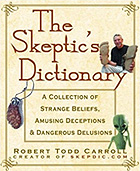From Abracadabra to Zombies | View All
hystero-epilepsy
An alleged disease discovered by Dr. Jean-Martin Charcot (1825-1893), one of the founders of modern neurology. Students came from all over the world to study under him in Paris, including Freud in 1885. Charcot used hypnosis as a diagnostic tool in his study of hysteria and influenced Freud's views on the origin of neurosis. Charcot made a number of important medical discoveries and even has a disease named after him (neurogenic arthropathy is also known as Charcot's joints).
At one point in his illustrious career, Charcot believed that he had discovered a new disease, which he called "hystero-epilepsy." The symptoms included "convulsions, contortions, fainting, and transient impairment of consciousness" (McHugh). He showed his students several examples of this new disease during his rounds at Salpêtrière Hospital.
A skeptical student, Joseph Babinski, decided that Charcot had invented rather than discovered hystero-epilepsy. The patients had come to the hospital with vague complaints of distress and demoralization. Charcot had persuaded them that they were victims of hystero-epilepsy and should join the others under his care. Charcot's interest in their problems, the encouragement of attendants, and the example of others on the same ward prompted patients to accept Charcot's view of them and eventually to display the expected symptoms. These symptoms resembled epilepsy, Babinski believed, because of a municipal decision to house epileptic and hysterical patients together (both having "episodic" conditions). The hysterical patients, already vulnerable to suggestion and persuasion, were continually subjected to life on the ward and to Charcot's neuropsychiatric examinations. They began to imitate the epileptic attacks they repeatedly witnessed (McHugh).
Babinski convinced Charcot that hystero-epilepsy was not a disorder and that doctors can induce symptoms in their patients. They separated the "hystero-epileptic" patients from each other and from staff members who had treated them. The patients were moved to the general ward of the hospital. The doctors then treated the patients by ignoring their hysterical behavior and encouraging the patients to work on their recovery. "The symptoms then gradually withered from lack of nourishing attention (McHugh)."
The lesson of Charcot seems lost on many therapists today, in particular the trauma-search (repressed memory) therapists who assume even before meeting their patients that they have probably been sexually abused, repressed the traumatic abuse and will suffer until the memories of abuse are brought to the surface in therapy. These therapists have no difficulty in finding patients who respond to their diagnoses and treatment, even though there is growing evidence that many of the memories of abuse that they elicit are false memories.
See also false memory, hypnosis, memory, multiple personality disorder, psychology, repressed memory therapy, satanic ritual abuse, New Age therapies, and unconscious mind.
further reading
book
websites
-
Multiple Personality Disorder (Dissociative Identity Disorder) by Paul R. McHugh MD, Henry Phipps Professor of Psychiatry and Director of the Department of Psychiatry and Behavioral Science at the Johns Hopkins Medical Institutions in Baltimore
- Trance and Trauma: Functional Nervous Disorders and the Subconscious Mind from Mind and Body: Rene Déscartes to William James by Robert H. Wozniak, Bryn Mawr College. Originally published in 1992 at Bethesda, MD & Washington, DC by the National Library of Medicine and the American Psychological Association.
last updated 05-Nov-2015


